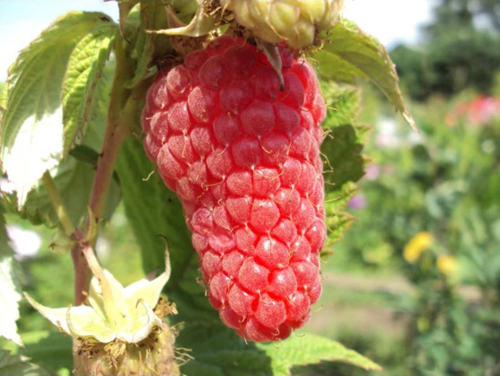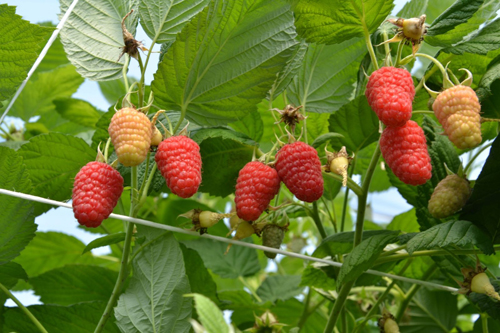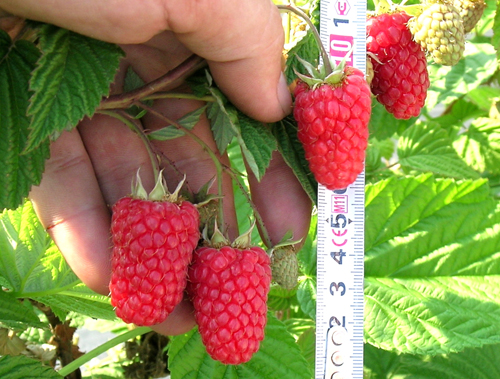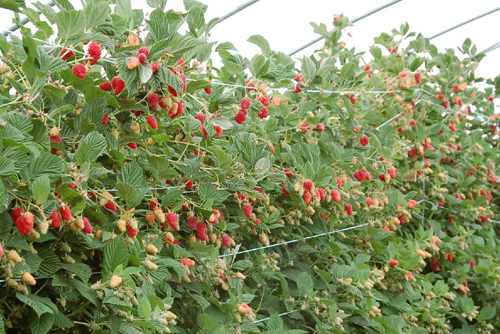Raspberry variety Sokolitsa
This is a young Polish variety, but it is already clear that it will undoubtedly enter the galaxy of legendary ones. It appeared on the Polish market after registration in 2010, and already in 2011 it began to be imported to Ukraine, Russia and Belarus. But active distribution among gardeners and summer residents began only in 2014-2015. An interesting little story about the place after which this raspberry is named.

Sokolica is one of the peaks of the picturesque Pieniny mountain range on the border of Poland and Slovakia. White-headed falcons used to nest on it, after which this peak was later named. Another great highlight of Sokolitsa is that it is crowned with a 500-year-old relict pine tree. Moreover, it resembles a Japanese bonsai in shape, bizarrely curving over a gaping abyss. Today it is one of the iconic tourism and selfie spots in Poland. But what the European novelty has already managed to fall in love with gardeners and farmers - more on this in our article below.
History of creation
Summer raspberry Sokolitsa is obtained from Sadowniczym Zakładzie Doświadczalnym Instytutu Sadownictwa i Kwiaciarstwa in Brzezna, Poland. Bred by Polish breeders - the recognized raspberry genius, Dr. Jan Danek, and the rising berry star, Dr. Agniezka Ozhel. The variety was obtained as a result of the main crossing of two clones numbered 96 131 × 96 221. In its creation, 4 more varieties were used, namely Malling Seedling, Malling Promise, Canby and Polana... The new variety was selected for registration under number 2 332. For temporary protection, name approval and verification, it was entered in the State Register of Varieties of Poland (COBORU) on 02.2010 under the number TS215. Officially approved and registered in the COBORU register from 02.2016 under number S 621 to 12.2046. Our heroine belongs to the Scientific Research Institute of Horticulture in Skierniewice, created in 2011 and belonging to the Ministry of Agriculture of Poland. License for distribution on the territory of Poland issued by the Institute of Horticulture and Floriculture, Brzezna,

Description
Sokolica is a Polish licensed summer raspberry dessert variety. Fruiting on overwintered two-year-old shoots. Despite his young age, the Poles are positioning him as a future replacement Lyachke... And this statement is fully justified.
A kind of mid-early ripening period. In the south, it begins to sing in the first decade of June. In Western, Central Ukraine and Poland, the collection begins after June 20. In Central Russia already in the first decade of July. To obtain very early berries, cultivation in greenhouses is recommended. There, the start of fruiting is shifted to 3 weeks. When grown in tunnels, the crop can be harvested at the end of May. In comparison with other early Polish varieties: when Radzieva's raspberries are already beginning to sing, Sokolitsa is still in bloom or is just starting to be tied. The difference with it is about a week, and in greenhouses - by 10 days. With Lyachka, the discrepancy is up to 5 days in favor of the early maturity of Lyachka, and the novelty of Pshekhiba will sing a week earlier.
Our heroine has good vigor, but the bush is relatively compact. During the season, a sufficient number of shoots grows in it, up to 10 pieces. The stems are medium in thickness, generally reaching a height of 1.5-1.7 meters, but under suitable growing conditions they grow up to 2 meters. And especially when cultivated in closed ground (greenhouses, tunnels), they can often reach 2.5 meters. Raspberry gives root shoots well. Nettle and young leaves can be lemon-green in color, reminiscent of chlorosis. Or they may have a reddish tint.

Shoots are strong, tough, erect, but arched at the top. They are slightly covered with thin, small and soft dark brown thorns.The average length of shoots is about 30 cm less than that of Lyachka's stems, but they are slightly longer than that of Radzieva. Falcon on the tops of young shoots can show slight remontability up to October. Especially with a long, warm autumn. Young shoots are juicy green, with age they can acquire an anthocyanin hue. Closer to winter, they ripen and become light brown. Laterals in the variety are of medium length (30-50 cm), well-branched, with sparse small spines. At each branching order, 20 or more fruits ripen.
The leaves are deep green, with a slight sheen. They are strongly corrugated, narrow, oval, mostly straight and slightly twisted. The edges of the leaves are composed of small, sharp and frequent denticles. Raspberry blooms profusely, together, starting in May. The flowers are medium in size, white in color, collected in numerous clusters.
The berries are chiseled, aligned, bright, pink-red in color, with a non-intense glossy shine and slight pubescence. Basically, the fruits are 2.5-4 cm in length, often grow up to 5 cm. The berries are fleshy, wide, elongated, blunt-conical, or rather even cylindrical. The nose is blunt, slightly rounded. The width of the fruits is on average 2-3 cm. The berries of the variety are large and very large, sometimes even huge. The average weight of raspberries in the season is 5-7 grams, but specimens up to 10-13 grams are often found. Moreover, the large size is not something unusual: very large berries are the standard for Sokolitsa. Drupes are medium and small, homogeneous, tightly linked to each other. The fruits are dense, firm, but the pulp is juicy, with a pleasant thick aroma. Contains a small amount of small seeds, almost imperceptible when consumed.

The fruits are effortlessly removed from the bush, do not crumble when picked, with a dry separation, do not flow. They are of very high quality, have high commercial characteristics. Do not darken after collection. What is remarkable, despite the large size of the berries, the hollow part inside the fruit is small. And this has a great effect on the commercial qualities, in particular, the transportability and keeping quality of the fruit improves. Another plus of the variety is the very amicable ripening of berries, which makes mechanized picking possible.
Sokolitsa fruits have really high tasting characteristics. They are sweet, but without sugary, juicy, with a rich raspberry flavor and a bright aftertaste. Sugar and acid are perfectly balanced in fruits. According to experts, our heroine scored 9 out of 10 possible points in this indicator. Raspberries are resistant to damage during harvest, storage and transportation. And also they do not rot, hanging on the bush, after ripening and during storage. Sokolitsa berries are generally very layable, transportable. When stored in a refrigerator, they retain high commercial characteristics for up to 6-7 days. And when transported in a small container and with proper cooling, they retain their quality for up to 5 days. The fruits of universal use. Suitable for both personal consumption and for sales in fresh berry markets. Berries are suitable for drying, freezing and all types of processing, as well as for use in cooking.
In 2014, NIWA Berry Breeding Ltd, Brzezna, assessed the acidity, soluble solids and ascorbic acid content of these raspberries. According to Agnezhka Ozhel, the fruits contain: titratable acids - 1.3%, BRIX level - 10.2%, ascorbic acid content - 35.0 mg / 100 g-1. According to the comparative characteristics of varieties, carried out in 2013 in Brzezna, the weight of 20 Sokolica berries was 84.5 grams, and the yield was 3.2 kg.

Our heroine is already objectively considered one of the best and most promising mid-early varieties in many respects. Including in terms of productivity.She has really excellent, consistently high yields. According to this indicator, it is already considered one of the leaders in its class. With competent agricultural technology, you can achieve really gorgeous harvests, especially in greenhouses. According to research data, its productivity is higher than that of Lyachka and Radziev up to 30% when grown in tunnels.
The yield from one bush is 5-7 kg, depending on agricultural technology and plant age. On an industrial scale (in open ground), productivity reaches 20 tons per hectare. And with competent agricultural technology, as well as the use of high-quality virus-free seedlings when planting on plantations, Sokolitsa can exceed this figure. Its high yield has been confirmed, among other things, in the Polish project "Malinowe factory". When cultivated in tunnels, the yield was 30 t / ha. The soil in the rows when growing raspberries was covered with polypropylene mats (agrotechnical). According to the agricultural technology of cultivating the variety, it is recommended to introduce organic matter into the soil, in particular manure, in an amount of 40-50 t / ha.
Our heroine is well suited for both amateur and commercial cultivation. It successfully shows itself in both open and protected ground conditions. The variety has good resistance to major diseases and pests of the crop, as well as a really high frost resistance. But it is poorly resistant to rust of raspberries and blackberries. The falcon is also characterized by good heat resistance. The variety has a well-developed root system. Due in part to this, it is drought tolerant. But to obtain high yields, of course, regular watering is required in the right amount.
Strengths
- Large and very large, sometimes just huge berries. They have not just 100, but 150% "wow-effect"!
- Chiseled, leveled, one-dimensional fruits of excellent quality.
- Excellent taste, high sugar content, balanced acidity and good aroma.
- Juicy pulp with few small seeds.
- High commercial characteristics of the fruits, they are dense, lying and highly transportable.
- Relatively low shoot growth, facilitating harvesting.
- Developed root system, high heat and frost resistance.
- Resistance to the main pests and diseases of raspberries, unlike, for example, the Lyachka variety.
- Really very high, stable yields.
- The versatility of the use of fruits.
Weak sides
- The need to install trellises or supports.
- Poor resistance to raspberry and blackberry rust.
- Insignificant manifestation of remontantity on young shoots in autumn.
- Produces a lot of root growth.
Since the variety is quite new, there is simply no clear information about all the disadvantages and lesions of diseases in the proper volume. But what Sokolitsa is showing now gives reason to hope that she will not have significant disadvantages in the future.
The early ripening period, the size and taste of the fruits, high rates of transportability, keeping quality and yield, as well as resistance to pests and diseases - all this makes Sokolitsa a welcome guest at any summer cottage when grown for personal consumption. And also an excellent choice for obtaining high profits from the sale of berries when cultivating raspberries on industrial plantations.
Author: Maxim Zarechny.








